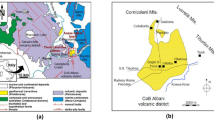Abstract
A review is presented on constructive techniques plus materials and the processes involved in degradation phenomena observed in two historical monuments: the Zambujeiro dolmen (Portugal) and the Roman Aqueduct of Carthage (Tunisia).
Dolmens are particularly impressive megalithic constructions for the dimensions of granite blocks. At Zambujeiro, the upright stones have undergone a catastrophic evolution after the archaeological exploitation due to accelerated weathering through a process apparently distinct from natural granite decay in nearby outcrops. The biological attack of granite minerals by lichen exudates has emphasized the hazardous character of bromine and more has been learnt about construction techniques, namely, the insertion in the mound of an impermeable clay stratum that hinders water penetration into the dolmen chamber.
The characterization of original Roman ashlar blocks, including masonry and the diagnosis of Byzantine and medieval reconstruction testimonies in the Aqueduct of Carthage were the object of a detailed study by X-ray diffraction and synchrotron radiation X-ray fluorescence. Traditional constructive techniques and local construction materials were studied and successive historical, modern and recent rehabilitations were reappraised.
Similar content being viewed by others
References
M.I. Prudêncio, M.O. Figueiredo, J.C. Waerenborgh, L.C.J. Pereira, M.A. Gouveia, T.P. Silva, I. Morgado, I.R. Costa, J.D. Rodrigues, ASMOSIA III Athens, ed. by Y. Maniatis et al. (Archetype Publ., London, 1995), p. 285
J.D. Rodrigues, M.I. Prudêncio, M.A. Gouveia, M.O. Figueiredo, T.P. Silva, Conservation of granitic rocks, ed. by J. Delgado Rodrigues, D. Costa (LNEC, Lisboa, 1996), p. 13, ISBN 972-49-1685-5
M.O. Figueiredo, T.P. Silva, M.I. Prudêncio, M.A. Gouveia, J.C. Waerenborgh, L.C. Pereira, Procd. 6th Nordic Conf. Application of Scientific Methods in Archaeology, Arkaeologiske Rapp. Esbjerg Museum 1, 153 (1993)
M.T. Ramos, M.O. Figueiredo, T.P. Silva, M.J. Basto, P. Chevallier, Biomonitoring of atmospheric pollution – BioMAP, (IAEA-TECDOC-1152, ISSN 1011-4289, 2000), p. 197
P. Chevallier, P. Dhez, F. Legrand, A. Erko, Y. Agafonov, L.A. Panchenko, A. Yashkin, J. Trace Microprobe Technol. 14, 517 (1996)
J. Wang, D. Piccot, P. Chevallier, F. Legrand, K. Abbas, Note CEA-N-2756, (Commissariat à l’Energie Atomique (CEA), Saclay, France, 1993), p. 231
F. Rakob, Dossiers d’Archéologie 38, 34 (1979)
M.O. Figueiredo, J.P. Veiga, T.P. Silva, Historical Constructions 2001, ed. by P.B. Lourenço, P. Roca, (Univ. Minho, Guimarães/Portugal, 2001), p. 391
M.O. Figueiredo, J.P. Veiga, T.P. Silva, A. Alvarez, F. Torrens, S. Khosrof, N. Ferchiou, Procd. 9th Int. Congr. on Deterioration & Conservation of Stone, Elsevier, 2, 641 (2000)
Author information
Authors and Affiliations
Corresponding author
Additional information
PACS
83.80.Nb; 64.70.Kb; 78.70.En; 41.60.Ap
Rights and permissions
About this article
Cite this article
Figueiredo, M., Silva, T. & Veiga, J. Analysis of degradation phenomena in ancient, traditional and improved building materials of historical monuments. Appl. Phys. A 92, 151–154 (2008). https://doi.org/10.1007/s00339-008-4466-6
Received:
Accepted:
Published:
Issue Date:
DOI: https://doi.org/10.1007/s00339-008-4466-6




